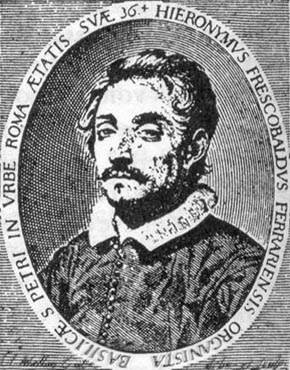

Italian keyboardist and composer. His father was a musician and a prominent Ferrarese citizen; he studied with the Ferrarese court organist Luzzaschi (a debt he often acknowledged in dedications), from whom he received training on Vicentino's chromatic archicembalo as well. He was named organist at the Accadernia della Morte in 1597 at the age of 14. At some point he came under the patronage of Guido Bentivoglio, a cleric and member of a powerful Ferrarese family. The duchy of Ferrara reverted to the papacy upon Alfonso's death in 1597; the principal Vatican figure in the affair, Cardinal Pietro Aldobrandini, promised a post at the papal court to Guido, who soon went to Rome, taking Frescobaldi with him. Girolamo was admitted to the Accademia di S. Cecilia in 1604 and became organist at S. Maria in Trastevere in 1607. He accompanied Guido to Flanders in 1607-8, where a set of his 5-part madrigals was published. He was summoned back to Rome by Guido's brother Enzo, a Vatican official, and was appointed organist of the Cappella Giulia, St. Peter's, upon his return; he worked also as a member of Enzo's household musica, though he was less than diligent in that post. He married in 1612 after fathering two illegitimate children by his future wife; by 1615 he seems to have left the service of the Bentivoglio family for that of Cardinal Aldobrandini, while the court of Mantua made an abortive effort to engage him in that same year.
The next thirteen years were his most fruitful in terms of output, with the two books of toccatas, sets of ricercars, canzonas, and capriecios, and a collection of ensemble canzonas appearing during this time. In addition, his fame as a keyboardist continued to grow; he took various engagements while keeping his posts at the Vatican and with the Aldobrandini family. He was in the employ of the Medici in Florence, 1628-34; his only works from this period are the two books of Arie musicali, encompassing strophic songs, through-composed madrigals, and works in stile recitativo. Returning again to Rome, he resumed playing at St. Peter's, in addition taking a post with Cardinal Francesco Barberini and appearing at the celebrated Oratorio del Crocifisso during Lent; the French viol player André Maugars commented in 1639 on his masterly improvisations at these Lenten performances. His international reputation brought Froberger to study with him in 1637-41. He took ill and died amidst the chaos of the final years of the Barberini papacy of Urban VII.
Frescobaldi's compositions were central to keyboard study until well into the next century; Gasparini was among those commending them, and J. S. Bach copied out the Fiori musicali(1635), a publication of liturgical organ music. Revised versions of earlier toccatas and ensemble canzonas show him to be concerned with the final state of his work.
Girolamo Frescobaldi is one of the most illustrious organists and composers we know. He is responsible for making a synthesis of all styles preceding his time and for combining subjectivity with logic, and dramatic passion with lyricism. Through his pupils, Froberger and Pachelbel, he wielded an indirect influence on J. S. Bach.